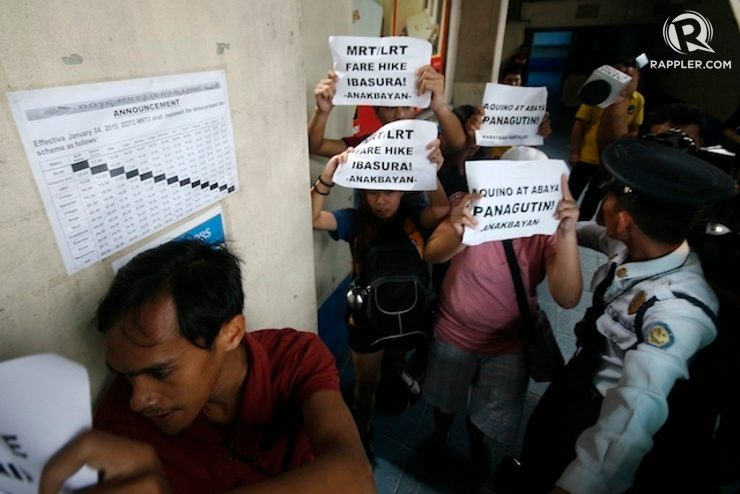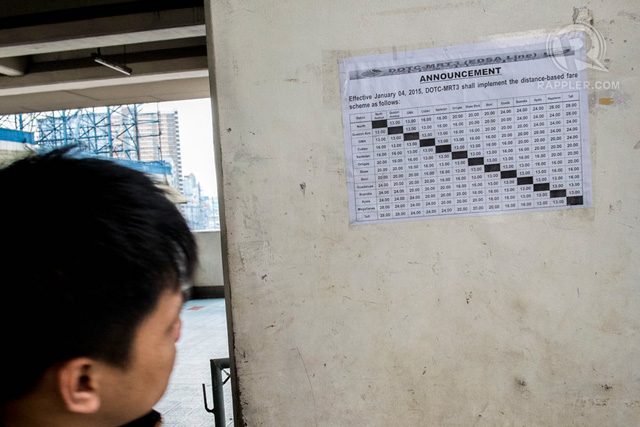SUMMARY
This is AI generated summarization, which may have errors. For context, always refer to the full article.

MANILA, Philippines (UPDATED) – Youth activists greeted the first day of the implementation of the fare hikes in the Metro Rail Transit (MRT) and Light Rail Transit (LRT) lines with a protest Sunday, January 4, expressing their opposition to the government’s move.
Dozens of youth activists held sit-down protests at the ticketing office of the North Avenue MRT station and other stations objecting to what they called the “baseless” fare increase in the LRT-1, LRT-2, and MRT3.
Starting Sunday, the maximum single journey fare in LRT-1 will increase to P30 and P25 for the LRT-2. MRT3 fares for the 17-kilometer stretch from North Avenue to Taft Avenue will increase from P15 to P28. (READ: Added fare, added burden)
The MRT3, which traverses through EDSA, serves as one of the most important public transportation lines in Metro Manila. Several MRT3 stations are located in business hubs.
“Not only is this fare hike a bad way to start the year, it is truly detestable, given that the current state of our train systems is far from being agreeable. President Aquino and his Cabinet are out of their minds if they think that the riding public will take these fare hikes lightly,” said Vencer Crisostomo, Anakbayan National chair.
According to Crisostomo, the Department of Transportation and Communications (DOTC) reportedly admitted that the fare hike will not lead to improvement of the trains’ service but will go to the private sector.
He added: “The fare increase is part of the government’s sweetheart deal with mega-consortiums which aim to squeeze more funds from commuters through vital transportation services. At the very heart of this issue is the Aquino government’s abandonment of public services and its total sell-out to private firms.”
Grace Poe: Fire hike a ‘betrayal’

Senator Grace Poe, who has been leading a Senate probe into the state of the MRT, reiterated her objection to the fire hike.
Poe said MRT officials did not mention the fare hike during the last hearing in December or during budget hearings last year. She said the Senate could have then removed the subsidy it allocated for the repair of the MRT.
“Nakakalungkot mang isipin pero para kasing pa-traydor ang kanilang galaw …. Parang wala naman silang puso na sasabihin nila ito kung kailan magbabakasyon na ang lahat ng mga institusyon tapos ‘yun pa ang bubulaga sa ating mga mananakay ng January 4. Halos unang araw ng pagtatrabaho bukas para sa marami sa ating mga kababayan tapos taas presyo kaagad,” Poe said in an interview on radio DZBB Sunday.
(It saddens me because it seems their act is a betrayal. It seems they are heartless not to consider that all institutions are on break and this is what will greet our commuters on January 4. Tomorrow is the first day of work for many of our compatriots and a fare hike is what will greet them.)
Poe said she will schedule a new hearing after Pope Francis’ visit to the Philippines on January 19, and will again invite Transportation Secretary Jun Abaya, who snubbed the inquiry last December due to a prior engagement.
The senator admitted that the fare hike was a “chicken and egg” situation, with MRT officials arguing that the fare should first be increased before better services can be offered.
“Why did they still ask for a subsidy [in the budget]? If they will get the funds for the repair from the fare hike, they should not have asked for the subsidy in the first place. Why didn’t they say this from the start so that we could have used the money for social welfare or education programs?”
Malacañang defended the fare increase, saying it’s a step to improve the train lines’ services.
“We can assure the public that the funds collected are spent on the much-needed improvements of our trains – better services, regular maintainence, and assuring the safety of all passengers,” Communication Secretary Sonny Coloma said in an interview with state-run Radyo ng Bayan Sunday.
Coloma added that it has been 10 years since the LRT/MRT fares changed. The last fare increase was for LRT-1 in 2003. LRT-2 has not changed its fares since it started its operations. MRT3 fares were even lowered to P17 from P34 in 1999.
“The halt of fare adjustment impedes the investment on large-scale improvements in facilities, like the acquisition of new train coaches currently being done by the administration,” he said.
Coloma maintained that the fare increase is part of the Philippine Development Plan for 2011 to 2016 principle of “user pay” – those who use the service more will pay more for their fare.
“The fare increase is just a way to realign our resources so it can be better used to improve our services to the public,” he added.
Lower maintenance rates?
Kabataan party-list representative Terry Ridon noted, however, that the operation and maintenance (OM) cost of MRT3 is actually lower than the previous fare rate.
Ridon said that by checking the proportion of fare revenues to the total operational costs of trains, the result would suggest that the MRT OM cost per passenger is only P9.11 – P0.89 to P5.89 less than the P10 to P15 fares charged.
“If we look at the data closely, OM costs can already be covered by the P10 – P15 fare rates. There is a shortage of funds due to the government’s onerous debts,” Ridon said.
He added: “The fare hike is simply unacceptable and is a heavy burden for workers and students who are the main patrons of our train lines. It’s also enraging to ask for an increase at a time when the cost of electricity, fuel and other basic utilities are also rising.”
Students, workers heavily affected
The fare hike is expected to affect students, among other commuters.
A 2009 study of Nielsen showed that students comprise around 30% of the ridership of LRT-1, and 42% of the ridership of LRT-2. MRT3 caters predominantly to white and blue collar workers.
The League of Filipino Students (LFS) slammed the fare increase, calling it a “heavy burden” for the thousands of students who ride the train daily.
“A typical student who rides either the LRT or MRT buys one to 2 stored value tickets per week under the previous fare matrix. Now, students need to buy 3-4 P100-peso stored value tickets for one week. This will make a huge dent in the already-tight budget of thousands of students and their families,” LFS spokesperson Charlotte Velasco said.
Velasco added, “Aquino and the DOTC should be held liable for imposing an additional burden to millions of train riders just to ensure that private companies will get their ROI.”
According to Pagkakaisa ng mga Samahan ng Tsuper at Operator Nationwide (PISTON) National President George San Mateo, the train lines’ fare hike will just add to the Filipino workers’ burden and an additional deduction to their small income.
“Corruption in these transportation systems must end, renegotiate MRT contract and make it a public ownership. The government must scrap privatization in LRT 1 & 2, and put appropriate annual budget for these services.” San Mateo added.
Meanwhile, Anakbayan vowed more protests in the coming days.
“Tomorrow, a series of protests will also be held in several MRT and LRT stations. Anakbayan will also be part of the Supreme Court petition that will be filed tomorrow to stop the fare increases,” Crisostomo said. – Rappler.com
Add a comment
How does this make you feel?
There are no comments yet. Add your comment to start the conversation.